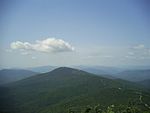Killington Peak

Killington Peak is the second highest summit in the Green Mountains and in the U.S. state of Vermont. It is located east of Rutland in south-central Vermont. Killington Peak is a stop on the Long Trail, which here shares its route with the Appalachian Trail. Traveling southbound on the Trail, it is the last 4,000-foot (1,200 m) peak close to the trail until Virginia. A ski resort, Killington Ski Resort, nicknamed "the beast of the east", is located on the mountain. A gondola transports skiers and non-hikers to the summit in winter, summer, and during fall leaf peeping season. There is a lodge near the peak which is complete with a restaurant and bar with panoramic views. In 1763, the mountain was known as Pisgah. Killington (a.k.a. Sherburne) lodging situations have changed over the years, from sleeping on barroom floors and barns on the mountain road, traveling up from nearby Rutland or Woodstock, to the present day, in which the vicinity has over 120 inns, lodges, and condominium complexes. Their sleeping capacity brings this Central Vermont region's tourist population to 60,000+ on prime winter weekends.
Excerpt from the Wikipedia article Killington Peak (License: CC BY-SA 3.0, Authors, Images).Killington Peak
Peak Walkway,
Geographical coordinates (GPS) Address Nearby Places Show on map
Geographical coordinates (GPS)
| Latitude | Longitude |
|---|---|
| N 43.604513 ° | E -72.8201024 ° |
Address
WJJR-FM (Rutland)
Peak Walkway
Vermont, United States
Open on Google Maps





